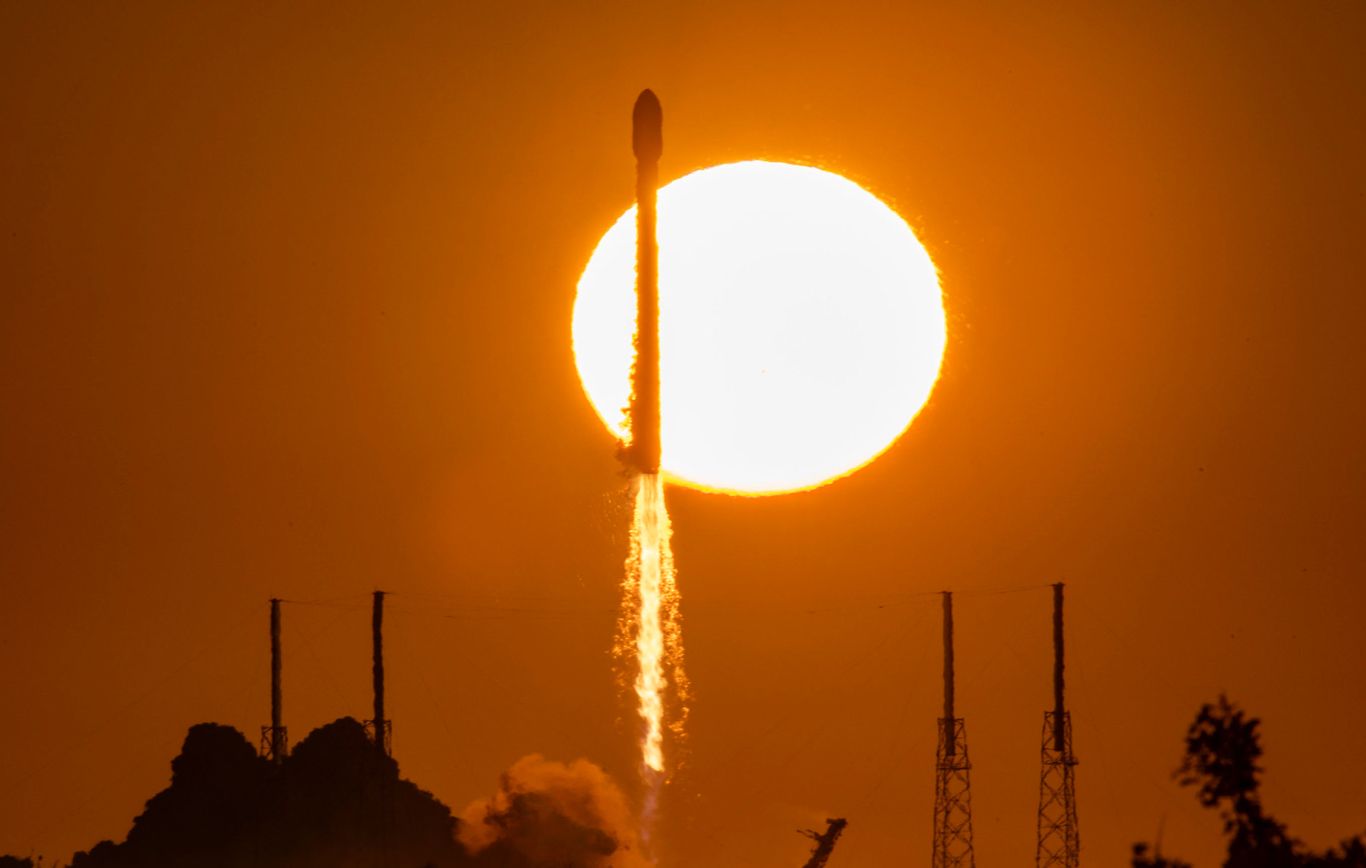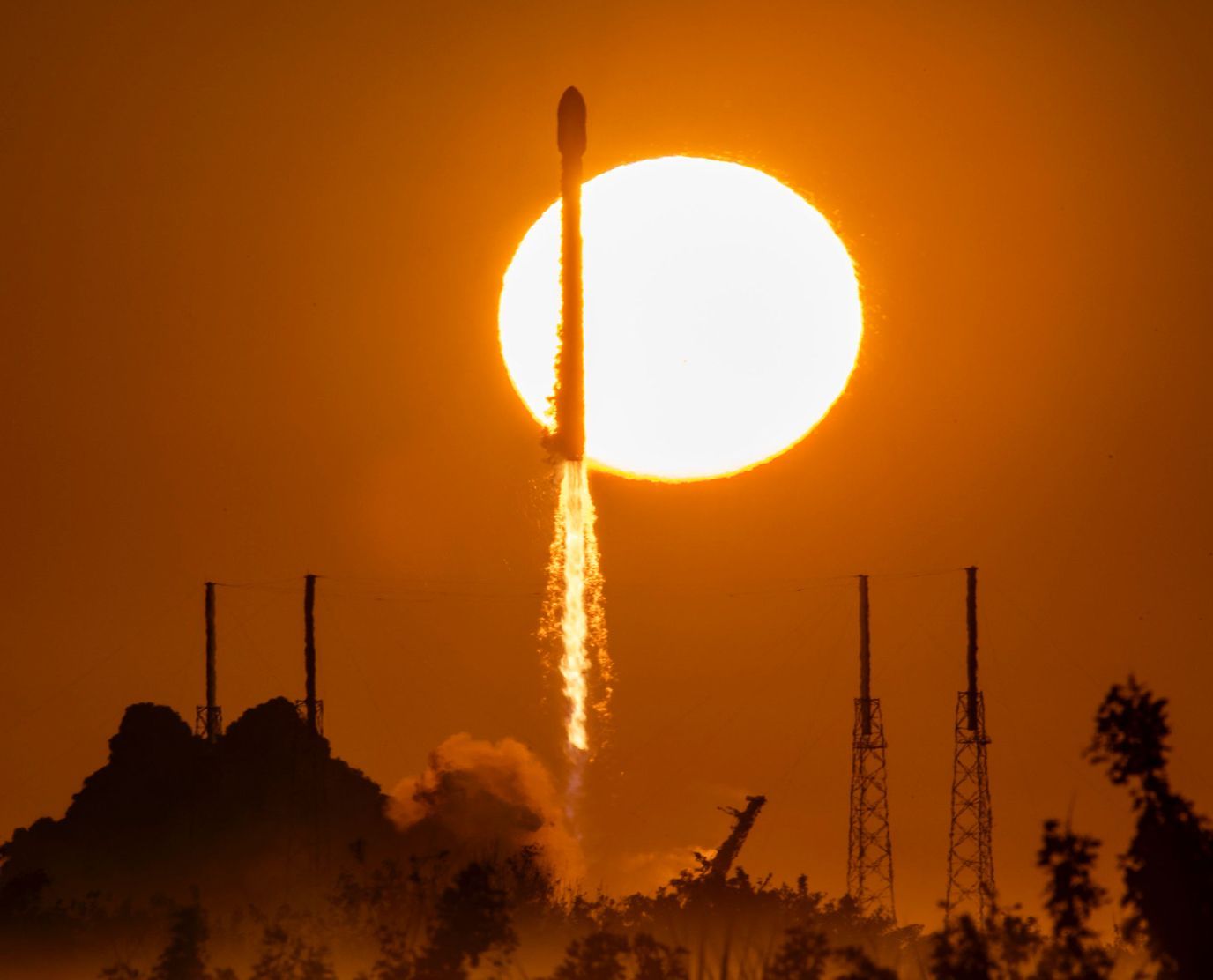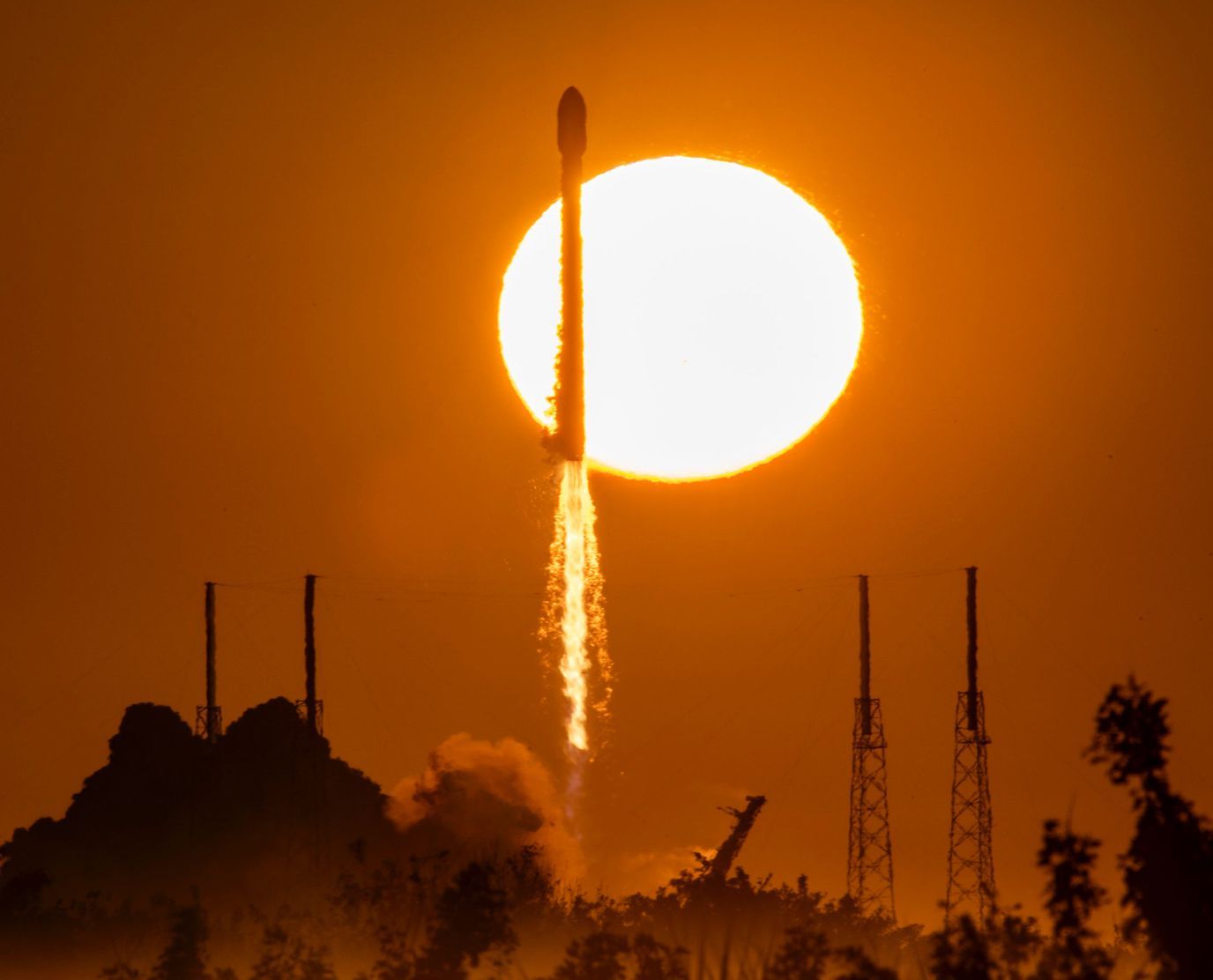17 Feb 2023
Space industry remains defiant, as nations begin to build regulatory frameworks

Launch demand remains high as SpaceX lead the market (Image: SpaceX)
Despite economic concerns, the space industry continues to move defiantly forwards. Last week we read news coming out of the SmallSat Symposium (California) that launch demand remains high, but there were also some concerns regrading the feasibility of new launch companies coming through, due to the competition faced from SpaceX. It’s certainly true that SpaceX continue to largely dictate the state of play in the launch market, even before the debut of Starship.
However, comments also coming out of the symposium have suggested that there will be the need for newer launch companies, and indeed they will play an important role in feeding increasing demand. According to Tom Choi of Saturn Satellite Networks, currently there are “not enough launch vehicles to fill that demand”. We are anticipating maiden launches from a number of new companies this year, but at the same time some are facing setbacks. New Glenn isn’t due to launch until 2024, Arianespace have almost expended all of their Ariane-5 rockets, with Ariane-6 yet to launch. Europe in particular will be rueing their lack of access to sovereign launch capabilities, after also losing out on Russian launches.
This may be an indication that the space industry can continue to march through the mud of current economic turmoil. Satellite demand remains high, and in the near future, launches will also be required for the vehicles needed to support and service this new orbital infrastructure.
Industry remains defiant in trying times
Chinese launch ambitions continue to clip at the heels of SpaceX and the US, and 2023 may be the year that we see the power of its commercial unleashed. According to plans laid out by a number of emerging commercial rocket companies, the number of launches could double in 2023. After witnessing the roaring success of the US private sector, we can assume that there are big moments ahead for China, especially when concepts of reusability are explored.
China’s private sector anticipates around 20 commercial launches this year, coming form companies such as Galactic Energy, Space Pioneer, Expace and Landscape. Similarly, there has been some more positive news for orbital launch company, Virgin Orbit. Their maiden UK launch faced problems in January, which led to the loss of the payloads. Whilst this wasn’t the news the company were looking for, it has been reported that the issue was down to an inexpensive filter in the second stage propulsion system, leading to the shutdown of the engine. Furthermore, the company has announced that it hopes to carry out a second attempt for launch at the UK Cornwall spaceport this year. Virgin Orbit has faced an uphill battle over the previous months, but continues to move forwards.
Blue Origin have also revealed details regarding their lunar exploration plans. Whilst it isn’t a launch date for their highly anticipated New Glenn launch vehicle, the company is developing technology for in-situ resource utilisation (ISRU), using the Moon’s soil to create solar cells and transmission wire. According to their resent blogpost, they can “make power systems on the Moon directly from materials that exist everywhere on the surface, without special substances brought from Earth,” (Blue Origin, 2023). Current tests using simulated lunar regolith in their reactor produces iron, silicon and aluminium, through “molten regolith electrolysis”. ISRU techniques will be vital for long-term lunar exploration, in not being able to transport everything from Earth. They go on to say that their method, known as Blue Alchemist, can “scale indefinitely, eliminating power as a constraint anywhere on the Moon.” Being able to produce and use solar cells on the Moon will be a significant step towards sourcing power, and enabling habitation.
Lastly, ESA have announced that they are closer to launch of their Jupiter Icy Moons Explorer mission (JUICE). The mission will explore the Moons Europa, Ganymede and Callisto by peering beneath their icy surface. The spacecraft is in French Guiana, and will soon be integrated with one of the last Ariane-5 rockets.

Will new stations build cooperation similar to ISS? (Image: Adobe Stock)
Legislative development but geopolitical setbacks
Throughout the past year we have often highlighted the necessity to build a universal regulatory framework in order to successfully govern and establish a peaceful future in outer space. Concepts such as the US-led Artemis Accords and China’s International Lunar Research Station (ILRS) plans could feasibly lay out a basis for this. However, deteriorating international relations and ongoing geopolitical confrontations mean that the these two superpowers, along with Russia, are struggling to agree on any kind of rulebook.
However, there is still at least one UN framework that is agreed upon unanimously between all major spacefaring nations, that is the Outer Space Treaty (OST). Whilst the treaty may now be somewhat outdated for the modern age, and could be ambiguous in regards to the appropriation of celestial resources, it does state that nations are responsible for governing the actions of their commercial sectors, with the treaty stating “The activities of non-governmental entities in outer space, including the moon and other celestial bodies, shall require authorization and continuing supervision by the appropriate State Party to the Treaty.”
It appears that efforts are now being made by the US National Space Council to establish such a framework, regulating commercial space activities and “mission authorisation”. The council has also been listening to industry representatives, and Chirag Parikh, executive secretary of the council, said that the feedback will enable a “clear, flexible, predicable” regulatory environment, maintaining the US as a leader in commercial space (Space News, 2023).
Similarly, Estonia has begun efforts to establish a Space Act, under the obligation outlined in the OST. The Ministry of Economic Affairs and Communications Head of Space, Paul Liias, said that “the development of the space sector along with the high traffic in the Earth's orbit, means regulations are needed to ensure cyber security, as well as environmentally friendly, responsible and sustainable development in space,” (news.err.ee, 2023). This is an encouraging sign and we may see other nations follow suit. However, we must also consider that these are national laws, and to what extent, through Article 6 of the OST, can unanimity between nations be established? There may still be the need to create some form of common rulebook, governing peaceful and sustainable space.
This also comes at a time when commercial activities in space are increasing. iSpace, Astrobotic and Intuitive Machines are coming closer to landing on the Moon and raising the curtain for commercial lunar activity, and this week NASA updated plans regarding the future of US commercial space stations. Two white papers related by NASA outline how they hope to work with the commercial sector who will be developing new stations, including how NASA astronauts will, for example, work with commercial astronauts in regards to maintenance of these stations. With the ISS coming closer to retirement, it’s clear that working alongside private companies in space is becoming the new norm, and so establishing rules that govern commercial activities is becoming more urgent.
Governing the activities of commercial space stations will also become more pressing on an International level, in regards to who which partners will be working on them. China recently lost a key partner for its Tiangong station when ESA head, Josef Aschbacher, announced that ESA will no longer be sending astronauts to the Chinese station. This week this news generated a bitter response from Chinese media, with Song Zhongping, a space watcher and TV commentator, telling the Global Times that the decision comes as a result of ESA being “kidnapped by the US amid the ongoing and prolonged Russia-Ukraine conflict,” (Global Times, 2023). With ESA now active only on the ISS, will they choose to work on commercial stations after the retirement of the ISS? Furthermore, could commercial space stations become a platform where adversaries can once again work together? For example, what would prevent Chinese, US and European companies from working together on a commercial station?
It’s vital that commercial activities in space are regulated, and that we don’t face the scenario of a new “wild west”. At the same time, perhaps it can also be the private sector who provide the platform where nations can rebuild relations, and ensure a cooperative and peaceful future in space.
External Links
This Week
*News articles posted here are not property of ANASDA GmbH and belong to their respected owners. Postings here are external links only.
Our future in space

Launch demand remains high as SpaceX lead the market (Image: SpaceX)
17 February 2023
Space industry remains defiant, as nations begin to build regulatory frameworks
Despite economic concerns, the space industry continues to move defiantly forwards. Last week we read news coming out of the SmallSat Symposium (California) that launch demand remains high, but there were also some concerns regrading the feasibility of new launch companies coming through, due to the competition faced from SpaceX. It’s certainly true that SpaceX continue to largely dictate the state of play in the launch market, even before the debut of Starship.
However, comments also coming out of the symposium have suggested that there will be the need for newer launch companies, and indeed they will play an important role in feeding increasing demand. According to Tom Choi of Saturn Satellite Networks, currently there are “not enough launch vehicles to fill that demand”. We are anticipating maiden launches from a number of new companies this year, but at the same time some are facing setbacks. New Glenn isn’t due to launch until 2024, Arianespace have almost expended all of their Ariane-5 rockets, with Ariane-6 yet to launch. Europe in particular will be rueing their lack of access to sovereign launch capabilities, after also losing out on Russian launches.
This may be an indication that the space industry can continue to march through the mud of current economic turmoil. Satellite demand remains high, and in the near future, launches will also be required for the vehicles needed to support and service this new orbital infrastructure.
Industry remains defiant in trying times
Chinese launch ambitions continue to clip at the heels of SpaceX and the US, and 2023 may be the year that we see the power of its commercial unleashed. According to plans laid out by a number of emerging commercial rocket companies, the number of launches could double in 2023. After witnessing the roaring success of the US private sector, we can assume that there are big moments ahead for China, especially when concepts of reusability are explored.
China’s private sector anticipates around 20 commercial launches this year, coming form companies such as Galactic Energy, Space Pioneer, Expace and Landscape. Similarly, there has been some more positive news for orbital launch company, Virgin Orbit. Their maiden UK launch faced problems in January, which led to the loss of the payloads. Whilst this wasn’t the news the company were looking for, it has been reported that the issue was down to an inexpensive filter in the second stage propulsion system, leading to the shutdown of the engine. Furthermore, the company has announced that it hopes to carry out a second attempt for launch at the UK Cornwall spaceport this year. Virgin Orbit has faced an uphill battle over the previous months, but continues to move forwards.
Blue Origin have also revealed details regarding their lunar exploration plans. Whilst it isn’t a launch date for their highly anticipated New Glenn launch vehicle, the company is developing technology for in-situ resource utilisation (ISRU), using the Moon’s soil to create solar cells and transmission wire. According to their resent blogpost, they can “make power systems on the Moon directly from materials that exist everywhere on the surface, without special substances brought from Earth,” (Blue Origin, 2023). Current tests using simulated lunar regolith in their reactor produces iron, silicon and aluminium, through “molten regolith electrolysis”. ISRU techniques will be vital for long-term lunar exploration, in not being able to transport everything from Earth. They go on to say that their method, known as Blue Alchemist, can “scale indefinitely, eliminating power as a constraint anywhere on the Moon.” Being able to produce and use solar cells on the Moon will be a significant step towards sourcing power, and enabling habitation.
Lastly, ESA have announced that they are closer to launch of their Jupiter Icy Moons Explorer mission (JUICE). The mission will explore the Moons Europa, Ganymede and Callisto by peering beneath their icy surface. The spacecraft is in French Guiana, and will soon be integrated with one of the last Ariane-5 rockets.

How will commercial stations build cooperation similar to ISS? (Image: Adobe Stock)
Legislative development but geopolitical setbacks
Throughout the past year we have often highlighted the necessity to build a universal regulatory framework in order to successfully govern and establish a peaceful future in outer space. Concepts such as the US-led Artemis Accords and China’s International Lunar Research Station (ILRS) plans could feasibly lay out a basis for this. However, deteriorating international relations and ongoing geopolitical confrontations mean that the these two superpowers, along with Russia, are struggling to agree on any kind of rulebook.
However, there is still at least one UN framework that is agreed upon unanimously between all major spacefaring nations, that is the Outer Space Treaty (OST). Whilst the treaty may now be somewhat outdated for the modern age, and could be ambiguous in regards to the appropriation of celestial resources, it does state that nations are responsible for governing the actions of their commercial sectors, with the treaty stating “The activities of non-governmental entities in outer space, including the moon and other celestial bodies, shall require authorization and continuing supervision by the appropriate State Party to the Treaty.”
It appears that efforts are now being made by the US National Space Council to establish such a framework, regulating commercial space activities and “mission authorisation”. The council has also been listening to industry representatives, and Chirag Parikh, executive secretary of the council, said that the feedback will enable a “clear, flexible, predicable” regulatory environment, maintaining the US as a leader in commercial space (Space News, 2023).
Similarly, Estonia has begun efforts to establish a Space Act, under the obligation outlined in the OST. The Ministry of Economic Affairs and Communications Head of Space, Paul Liias, said that “the development of the space sector along with the high traffic in the Earth's orbit, means regulations are needed to ensure cyber security, as well as environmentally friendly, responsible and sustainable development in space,” (news.err.ee, 2023). This is an encouraging sign and we may see other nations follow suit. However, we must also consider that these are national laws, and to what extent, through Article 6 of the OST, can unanimity between nations be established? There may still be the need to create some form of common rulebook, governing peaceful and sustainable space.
This also comes at a time when commercial activities in space are increasing. iSpace, Astrobotic and Intuitive Machines are coming closer to landing on the Moon and raising the curtain for commercial lunar activity, and this week NASA updated plans regarding the future of US commercial space stations. Two white papers related by NASA outline how they hope to work with the commercial sector who will be developing new stations, including how NASA astronauts will, for example, work with commercial astronauts in regards to maintenance of these stations. With the ISS coming closer to retirement, it’s clear that working alongside private companies in space is becoming the new norm, and so establishing rules that govern commercial activities is becoming more urgent.
Governing the activities of commercial space stations will also become more pressing on an International level, in regards to who which partners will be working on them. China recently lost a key partner for its Tiangong station when ESA head, Josef Aschbacher, announced that ESA will no longer be sending astronauts to the Chinese station. This week this news generated a bitter response from Chinese media, with Song Zhongping, a space watcher and TV commentator, telling the Global Times that the decision comes as a result of ESA being “kidnapped by the US amid the ongoing and prolonged Russia-Ukraine conflict,” (Global Times, 2023). With ESA now active only on the ISS, will they choose to work on commercial stations after the retirement of the ISS? Furthermore, could commercial space stations become a platform where adversaries can once again work together? For example, what would prevent Chinese, US and European companies from working together on a commercial station?
It’s vital that commercial activities in space are regulated, and that we don’t face the scenario of a new “wild west”. At the same time, perhaps it can also be the private sector who provide the platform where nations can rebuild relations, and ensure a cooperative and peaceful future in space.
Share this article
External Links
This Week
*News articles posted here are not property of ANASDA GmbH and belong to their respected owners. Postings here are external links only.
17 Feb 2023
Space industry remains defiant, as nations begin to build regulatory frameworks

Launch demand remains high as SpaceX lead the market (Image: SpaceX)
Despite economic concerns, the space industry continues to move defiantly forwards. Last week we read news coming out of the SmallSat Symposium (California) that launch demand remains high, but there were also some concerns regrading the feasibility of new launch companies coming through, due to the competition faced from SpaceX. It’s certainly true that SpaceX continue to largely dictate the state of play in the launch market, even before the debut of Starship.
However, comments also coming out of the symposium have suggested that there will be the need for newer launch companies, and indeed they will play an important role in feeding increasing demand. According to Tom Choi of Saturn Satellite Networks, currently there are “not enough launch vehicles to fill that demand”. We are anticipating maiden launches from a number of new companies this year, but at the same time some are facing setbacks. New Glenn isn’t due to launch until 2024, Arianespace have almost expended all of their Ariane-5 rockets, with Ariane-6 yet to launch. Europe in particular will be rueing their lack of access to sovereign launch capabilities, after also losing out on Russian launches.
This may be an indication that the space industry can continue to march through the mud of current economic turmoil. Satellite demand remains high, and in the near future, launches will also be required for the vehicles needed to support and service this new orbital infrastructure.
Industry remains defiant in trying times
Chinese launch ambitions continue to clip at the heels of SpaceX and the US, and 2023 may be the year that we see the power of its commercial unleashed. According to plans laid out by a number of emerging commercial rocket companies, the number of launches could double in 2023. After witnessing the roaring success of the US private sector, we can assume that there are big moments ahead for China, especially when concepts of reusability are explored.
China’s private sector anticipates around 20 commercial launches this year, coming form companies such as Galactic Energy, Space Pioneer, Expace and Landscape. Similarly, there has been some more positive news for orbital launch company, Virgin Orbit. Their maiden UK launch faced problems in January, which led to the loss of the payloads. Whilst this wasn’t the news the company were looking for, it has been reported that the issue was down to an inexpensive filter in the second stage propulsion system, leading to the shutdown of the engine. Furthermore, the company has announced that it hopes to carry out a second attempt for launch at the UK Cornwall spaceport this year. Virgin Orbit has faced an uphill battle over the previous months, but continues to move forwards.
Blue Origin have also revealed details regarding their lunar exploration plans. Whilst it isn’t a launch date for their highly anticipated New Glenn launch vehicle, the company is developing technology for in-situ resource utilisation (ISRU), using the Moon’s soil to create solar cells and transmission wire. According to their resent blogpost, they can “make power systems on the Moon directly from materials that exist everywhere on the surface, without special substances brought from Earth,” (Blue Origin, 2023). Current tests using simulated lunar regolith in their reactor produces iron, silicon and aluminium, through “molten regolith electrolysis”. ISRU techniques will be vital for long-term lunar exploration, in not being able to transport everything from Earth. They go on to say that their method, known as Blue Alchemist, can “scale indefinitely, eliminating power as a constraint anywhere on the Moon.” Being able to produce and use solar cells on the Moon will be a significant step towards sourcing power, and enabling habitation.
Lastly, ESA have announced that they are closer to launch of their Jupiter Icy Moons Explorer mission (JUICE). The mission will explore the Moons Europa, Ganymede and Callisto by peering beneath their icy surface. The spacecraft is in French Guiana, and will soon be integrated with one of the last Ariane-5 rockets.

How will commercial stations build cooperation similar to ISS? (Image: Adobe Stock)
Legislative development but geopolitical setbacks
Throughout the past year we have often highlighted the necessity to build a universal regulatory framework in order to successfully govern and establish a peaceful future in outer space. Concepts such as the US-led Artemis Accords and China’s International Lunar Research Station (ILRS) plans could feasibly lay out a basis for this. However, deteriorating international relations and ongoing geopolitical confrontations mean that the these two superpowers, along with Russia, are struggling to agree on any kind of rulebook.
However, there is still at least one UN framework that is agreed upon unanimously between all major spacefaring nations, that is the Outer Space Treaty (OST). Whilst the treaty may now be somewhat outdated for the modern age, and could be ambiguous in regards to the appropriation of celestial resources, it does state that nations are responsible for governing the actions of their commercial sectors, with the treaty stating “The activities of non-governmental entities in outer space, including the moon and other celestial bodies, shall require authorization and continuing supervision by the appropriate State Party to the Treaty.”
It appears that efforts are now being made by the US National Space Council to establish such a framework, regulating commercial space activities and “mission authorisation”. The council has also been listening to industry representatives, and Chirag Parikh, executive secretary of the council, said that the feedback will enable a “clear, flexible, predicable” regulatory environment, maintaining the US as a leader in commercial space (Space News, 2023).
Similarly, Estonia has begun efforts to establish a Space Act, under the obligation outlined in the OST. The Ministry of Economic Affairs and Communications Head of Space, Paul Liias, said that “the development of the space sector along with the high traffic in the Earth's orbit, means regulations are needed to ensure cyber security, as well as environmentally friendly, responsible and sustainable development in space,” (news.err.ee, 2023). This is an encouraging sign and we may see other nations follow suit. However, we must also consider that these are national laws, and to what extent, through Article 6 of the OST, can unanimity between nations be established? There may still be the need to create some form of common rulebook, governing peaceful and sustainable space.
This also comes at a time when commercial activities in space are increasing. iSpace, Astrobotic and Intuitive Machines are coming closer to landing on the Moon and raising the curtain for commercial lunar activity, and this week NASA updated plans regarding the future of US commercial space stations. Two white papers related by NASA outline how they hope to work with the commercial sector who will be developing new stations, including how NASA astronauts will, for example, work with commercial astronauts in regards to maintenance of these stations. With the ISS coming closer to retirement, it’s clear that working alongside private companies in space is becoming the new norm, and so establishing rules that govern commercial activities is becoming more urgent.
Governing the activities of commercial space stations will also become more pressing on an International level, in regards to who which partners will be working on them. China recently lost a key partner for its Tiangong station when ESA head, Josef Aschbacher, announced that ESA will no longer be sending astronauts to the Chinese station. This week this news generated a bitter response from Chinese media, with Song Zhongping, a space watcher and TV commentator, telling the Global Times that the decision comes as a result of ESA being “kidnapped by the US amid the ongoing and prolonged Russia-Ukraine conflict,” (Global Times, 2023). With ESA now active only on the ISS, will they choose to work on commercial stations after the retirement of the ISS? Furthermore, could commercial space stations become a platform where adversaries can once again work together? For example, what would prevent Chinese, US and European companies from working together on a commercial station?
It’s vital that commercial activities in space are regulated, and that we don’t face the scenario of a new “wild west”. At the same time, perhaps it can also be the private sector who provide the platform where nations can rebuild relations, and ensure a cooperative and peaceful future in space.
Share this article
External Links
This Week
*News articles posted here are not property of ANASDA GmbH and belong to their respected owners. Postings here are external links only.













